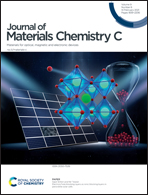The YMgB5O10 crystal preparation and attractive multi-wavelength emission characteristics of doping Nd3+ ions†
Abstract
The pure and Nd3+-doped YMgB5O10 (YMB,Nd:YMB) crystals were grown successfully by the top-seeded solution growth method with composite fluxes, namely, Li2O–B2O3–LiF. The systematic investigation of the crystal structure, transmission spectrum, band gap, thermal properties, laser damage threshold and hardness for the YMB crystal, and polarized absorption and fluorescence spectra, fluorescence lifetimes and laser propeties for the Nd:YMB crystal were reported. Based on the J–O theory, spectroscopic parameters (including line strengths, J–O intensity, spontaneous transition rates, fluorescence branching ratios and radiative lifetimes) have been calculated in detail. The excellent physicochemical properties, such as the large band gap (5.6 eV), laser damage threshold (2.6 GW cm−2), hardness (6.5 Mohs) and thermal conductivity (5.94 W m−1 K−1, RT), show the great potential applied to the high-power laser system. The wide absorption band (FWHM, 21.2 nm, E//Y) at around 800 nm makes Nd:YMB quite suitable for the efficient pumping of AlGaAs laser diodes. The intense multi-wavelength emissions and spectral anisotropy characteristics can be observed clearly in the 850–930 nm, 1020–1100 nm and 1300–1430 nm polarized fluorescence spectra, which make it possible to realize multi-wavelength laser operation at around 0.89, 1.06 and 1.32 μm, respectively. The dual-wavelength Nd:YMB laser working at 1054 and 1090 nm with a maximum output power of 1.3 W and a slope efficiency of 31.9% was generated, which may be a potential light source for THz generation with a large frequency difference of 9.4 THz through difference frequency interactions. The results indicate that Nd:YMB is a promising multi-wavelength laser crystal.



 Please wait while we load your content...
Please wait while we load your content...